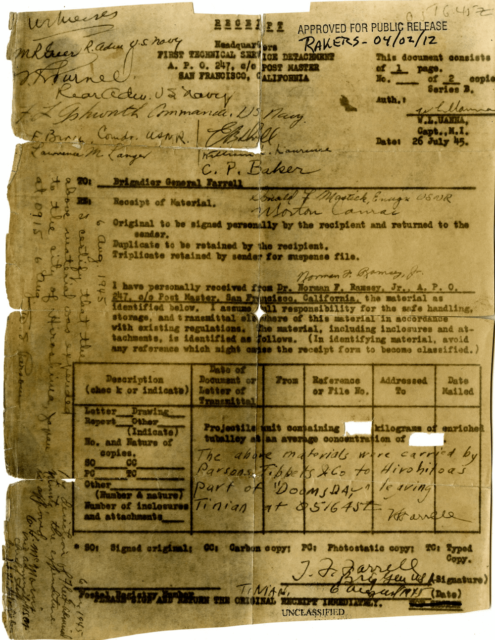One of history’s most important receipts is the one documenting the successful delivery and deployment of Little Boy, the atomic bomb dropped on Hiroshima during World War II. Following years of research and billions of dollars invested in its development, the bomb was transported across the Pacific and entrusted to American forces on Tinian. This handover led to the signing of a receipt that may be the most chilling, yet extraordinary, ever created.
Manhattan Project

In the late 1930s, European physicists sent a letter to US President Franklin D. Roosevelt, warning him about atomic weapons research taking place in Germany. At that time, the United States had been conducting its own research on the subject, but on a much smaller scale.
The pace of research in the U.S. accelerated after Roosevelt received the Einstein–Szilárd letter and additional intelligence reports about Germany’s advancements. By 1942, the Manhattan Project was launched, transforming the ongoing atomic weapons research into a full-scale military program.
While the Manhattan Project is most famous for developing the atomic bomb, it also included a vast array of smaller programs focused on specific tasks. In fact, the majority of the project’s resources were dedicated to producing fissile material for the bombs. The total cost amounted to just under $2 billion.
The Manhattan Project oversaw the development of two atomic bomb designs: the implosion-type, which used plutonium, and the gun-type, which utilized uranium. Plutonium was easier to produce, but the implosion-type design was far more complex. Because confidence in its feasibility was limited, it became the only design to undergo testing before deployment. Meanwhile, the first completed gun-type bomb, Little Boy, used up all of the project’s uranium-235 supply, leaving no material for a test.
The Trinity Test on July 16, 1945, marked the first detonation of an atomic weapon and confirmed the implosion-type bomb’s success. On the same day, Little Boy was transported aboard the USS Indianapolis (CA-35), bound for Tinian. Due to the cargo’s extreme danger, its transfer required lots of documentation.
A receipt was drawn up for the Little Boy atomic bomb

One of the official pieces of documentation for the delivery of Little Boy is a tattered receipt, perhaps one of the most unique in history. It was signed by Thomas Ferrell, the Deputy Director of the Manhattan Project, to confirm the successful handover of much of Little Boy‘s components from Dr. Norman F. Ramsey.
Ramsey left the US onboard the USS Indianapolis, which made the journey across the Pacific Ocean in just 10 days. After arriving in Tinian, Ramsey signed over Little Boy to Ferrell. However, the receipt wasn’t just proof of the delivery of the atomic bomb – it also confirmed its use.
Regardless of Hiroshima‘s destruction, bureaucratic procedure required a piece of paper to confirm the use of the atomic bomb. To confirm this, Fleet Adm. Chester Nimitz‘s Chief of Staff signed the receipt, writing, “By direction of Fleet Admiral Nimitz, the expenditure of this item is approved.”
Another signature on the receipt is that of William S. Parsons, the weaponeer onboard Enola Gay, the Boeing B-29 Superfortress that dropped Little Boy. He wrote, “I certify that the above materials was expended to the city of Hiroshima, Japan at 0915 6 Aug.”
More from us: Wait for Me, Daddy: The True Story Behind the Iconic World War II Photo
Want War History Online‘s content sent directly to your inbox? Sign up for our newsletter here!
After it was signed, Ferrell kept hold of the atomic bomb’s receipt and had crew members on Tinian sign it. For the rest of his life, he kept the historical document in his wallet, and it’s now the only example of its kind known to exist. The receipt was donated to the US Army Heritage and Education Center in Carlisle, Pennsylvania by Ferrell’s family, where it remains today.
